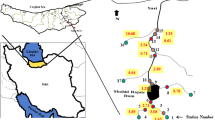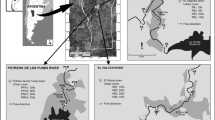Abstract
Urbanization can cause significant changes in the integrity of fluvial ecosystems, which makes it necessary to assess environmental conditions of areas where population growth rates are high. A study of the environmental quality of Chorrillos River (San Luis-Argentina) and its tributaries was carried out in order to evaluate the potential effect of an urbanization gradient. Six sites were sampled along the main course and tributaries of the river. Urbanization variables were measured and included to calculate an Urbanization Index. Physical–chemical analyses were performed in water samples to evaluate water quality through the use of a simplified index of water quality (SIWQ). Plants, macroinvertebrates, and amphibians metrics were used to assess the biological state of the studied sites. The Urbanization Index varied significantly between sites and was significantly correlated to the SIWQ. However, no significant correlations were found between SIWQ and macroinvertebrates and amphibians variables. Water quality of Chorrillos River and its tributaries is good, but it is affected by anthropic influences as reflected by the declining of SIWQ values. Although biological sampling constitutes an important tool in the assessment of water quality of rivers, in this report biological results were not conclusive.




Similar content being viewed by others
References
Adams, S., & Greeley, M. (2000). Ecotoxicological indicators of water quality: using multi-response indicators to assess the health of aquatic ecosystems. Water, Air, and Soil Pollution, 123, 103–115.
Agüero, N., Moglia, M., & Jofré, M. (2010). Are the pattern of abundance and distribution of anuran related with the structure of plant communities in aquatic habitats of San Luis city (Argentina)? Neotropical Biology and Conservation, 5(2), 63–76.
Almeida, C., Quintar, S., Gonzalez, P., & Mallea, M. (2007). Influence of urbanization and tourist activities on the water quality of the Potrero de los Funes River (San Luis-Argentina). Environmental Monitoring and Assessment, 133, 459–465.
Almeida, C., Oliva González, M., Mallea, M., & González, P. (2012). A recreational water quality index using chemical, physical and microbiological parameters. Environmental Science Pollution Research, 19(8), 3400–3411.
APHA. (2005). Standard methods for the examination of water and wastewater (p. 979). Washington, DC: American Public Health Association.
Bagur, M. G., Morales, S., & López-Chicano, M. (2009). Evaluation of the environmental contamination at an abandoned mining site using multivariate statistical techniques. The Rodalquilar (Southern Spain) mining district. Talanta, 80(1), 377–384.
Barnes, K., Morgan, J., & Roberge, M. (2002). Impervious surfaces and the quality of natural and built environments. Baltimore: Department of Geography and Environmental Planning Towson University.
Bode, R. W., & Novak, M. A. (1995). Development and application of biological impairment criteria for rivers and streams in New York State. In W. S. Davis & T. P. Simon (Eds.), Biological assessment and criteria; tools for water resource planning and decision making. Ann Arbor: Lewis Publishers.
Braun-Blanquet, J. (1928). Pflanzensoziologie (1st ed.). Berlin: Springer.
Braun-Blanquet, J. (1932). Plant sociology: the study of plant communities. New York: McGraw-Hill.
Brooks, R. (2000). Annual and seasonal variation and the effects of hydroperiod on benthic macroinvertebrates of seasonal forest (“vernal”) ponds in central Massachusetts, USA. Wetlands, 20(4), 707–715.
Burger, J. (2006). Bioindicators: types, development, and use in ecological assessment and research. Environmental Bioindicators, 1, 1–18.
Calderon, M., & Jofré, M. (2011). Hypsiboas pulchellus (Montevideo Treefrog, Ranita del Zarzal). Argentina: San Luis Province. Herpetological Review, 42(3), 385. Geographic Distribution.
Canter, L., & Atkinson, S. F. (2011). Multiple uses of indicators and indices in cumulative effects assessment and management. Environmental Impact Assessment Review, 31, 491–501.
Carignan, V., & Villard, M. (2002). Selecting indicator species to monitor ecological integrity: a review. Environmental Monitoring and Assessment, 78, 45–61.
Carle, M., Halpin, P., & Stow, C. (2005). Patterns of watershed urbanization and impacts on water quality. Journal of American Water Resources Association, 42(3), 693–708.
Cei, J. M. (1980). Amphibians of Argentina. Firenze, N.S. Monografía 2, Monitore Zoologico Italiano.
Ector, L., & Rimet, F. (2005). In S. Lek, M. Scardi, P. Verdonschot, J. Descy, & Park (Eds.), Using bioindicators to assess rivers in Europe: an overview in modelling community structure in freshwater ecosystems (pp. 7–19). Berlin: Springer.
Faulkner, S. (2004). Urbanization impacts on the structure and function of forested wetlands. Urban Ecosystems, 7(2), 89–106.
Garbagnati, M. A., González, S. P., Antón, R. I., & Mallea, M. A. (2005). Características físico-químicas, capacidad buffer y establecimiento de la línea base ambiental del Río Grande, San Luis, Argentina. Ecología Australia, 15, 59–71.
Hamer, A., & McDonnell, M. (2008). Amphibian ecology and conservation in the urbanising world: A review. Biological Conservation, 141(10), 2432–2449.
Helena, B., Pardo, R., Vega, M., Barrado, E., Fernández, J. M., & Fernández, L. (2000). Temporal evolution of groundwater composition in an alluvial aquifer (Pisuerga River, Spain) by principal component analysis. Water Research, 34, 807–816.
Hodkinson, I., & Jackson, J. (2005). Terrestrial and aquatic invertebrates as bioindicators for environmental monitoring, with particular reference to mountain ecosystems. Environmental Management, 35(5), 649–666.
Instituto Nacional de Estadística y Censos (INDEC) (2010). Resultados definitivos censo 2010. http://www.censo2010.indec.gov.ar/resultadosdefinitivos.asp. Accesed 10 March 2012.
Kalesnik, A., & Malvárez, A. I. (2004). Las especies exóticas invasoras en los sistemas de humedales. El caso del Delta inferior del Río Paraná. INSUGEO. Miscelánea, 12, 131–138.
Kowarik, I. (1995). On the role of alien species in urban flora and vegetation. In P. Pyšek, K. Prach, M. Rejmánek, & M. Wade (Eds.), Plant invasions—general aspects and special problems. Amsterdam: SPB Academic Publishing.
Kühn, I., Brandl, R., & Klotz, S. (2004). The flora of German cities is naturally species rich. Evolutionary Ecology Research, 6, 749–764.
Leynaud, G. C., Pelegrin, N., & Lescano, J. N. (2006). Anfibios y Reptiles. In E. H. Bucher (Ed.), Bañados del río Dulce y Laguna Mar Chiquita. Córdoba, Argentina: Academia Nacional de Ciencias.
Liston, S. (2006). Interactions between nutrient availability and hydroperiod shape macroinvertebrate communities in Florida Everglades marshes. Hydrobiologia, 569(1), 343–357.
Longing, S., & Haggard, B. (2010). Biological assessment to support ecological recovery of a degraded headwater system. Environmental Management, 46(3), 459–470.
Márquez, J., & Dalmasso, A. D. (2003). Las comunidades de ambientes húmedos del Parque Nacional El Leoncito, San Juan, Argentina. Multequina, 12, 55–67.
McKinney, M. (2002). Urbanization, biodiversity, and conservation. BioScience, 52(10), 883–890.
McKinney, M. (2006). Urbanization as a major cause of biotic homogenization. Biological Conservation, 127(3), 247–260.
McKinney, M. (2008). Effects of urbanization on species richness: a review of plants and animals. Urban Ecosystems, 11(2), 161–176.
Metcalfe-Smith, J. (1994). Biological water-quality assessment of rivers: use of macroinvertebrate community. In P. Calow & G. E. Petts (Eds.), The rivers handbook (II) (pp. 144–170). Oxford: Blackwell Science.
Muenz, T., Golladay, S., Vellidis, G., & Smith, L. (2006). Stream buffer effectiveness in an agriculturally influenced area, southwestern Georgia: responses of water quality, macroinvertebrates, and amphibians. Environmental Quality, 35(5), 1924–1938.
Nievas, R. (2011). Vegetación exótica de la localidad de Potrero de los Funes (San Luis-Argentina) y su relación con factores edáficos y de disturbio antrópico. Undergraduate Thesis, Universidad Nacional de San Luis.
Oliva González, S., Almeida, C., Quintar, S., Mallea, M., & González, P. (2011). Application of multivariate statistical techniques to evaluate organic pollution on a river in Argentina. Revista Ambiente y Agua-An Interdisciplinary Journal of Applied Science, 6(3), 27–42.
Oscoz, J., Gomá, J., Ector, L., Cambra, J., Pardos, M., & Durán, C. (2007). Estudio comparativo del estado ecológico de los ríos de la cuenca del Ebro mediante macroinvertebrados y diatomeas. Limnética, 26(1), 143–158.
Packman, J., Comings, K., Booth, D. (1999). Using turbidity to determine total suspended solids in urbanizing streams in the Puget Lowlands. In Managing Change in Water Resources and the Environment, Proceedings of the Canadian Water Resources Association Annual Meeting, Vancouver.
Pillsbury, F., & Miller, J. (2008). Habitat and landscape characteristics underlying anuran community structure along an urban–rural gradient. Ecological Applications, 18(5), 1107–1118.
Queralt, R. (1982). La calidad de las aguas en los ríos. Tecnología del agua, 4, 49–57.
Resh, V. H., & Unzicker, J. D. (1975). Water quality monitoring and aquatic organisms: the importance of species identification. Water Quality Monitoring, 47(1), 9–19.
Ridley, S., Busteed, G., Kats, L., Vandergon, T., Lee, L., Dagit, R., et al. (2005). Effects of urbanization on the distribution and abundance of amphibians and invasive species in Southern California streams. Conservation Biology, 19(6), 1894–1907.
Roux, D., Van Vliet, H., & Van Veelen, M. (1993). Towards integrated water quality monitoring: assessment of ecosystem health. Water SA, 19(4), 275–280.
Sanabria, E. A., Quiroga, L. B., & Acosta, J. C. (2005). Patrones de actividad temporal estacional y uso de microhábitat de una población de adultos de Bufo arenarum, en los humedales de Zonda, San Juan Argentina. Boletín de la Sociedad Herpetológica Mexicana, 13(2), 61–65.
Sewell, D., & Griffiths, R. (2009). Can a single amphibian species be a good biodiversity indicator? Diversity, 1(2), 102–117.
Stephens, K., Graham, P., & Reid, D. (2002). Stromwaters planning: a guide for British Columbia (Vol. 2, pp. 1–13). Vancouver, BC: Greater Vacouver Regional District.
Stribling, J.B., Jessup, B.K., White, J.S., Boward, D., Hurd, M. (1998). Development of a benthic index of biotic integrity for Maryland streams. Report CBWP-EA-98-3.
Stuart, S., Chanson, J., Cox, N., Young, B., Rodrigues, A., Fischman, D., et al. (2004). Status and trends of amphibian declines and extinctions worldwide. Science, 306(3), 1783–1786.
Suárez, M. L. (2002). Las riberas de los ríos mediterráneos y su calidad: el uso del índice QBR. Limnética, 21(3–4), 135–148.
Sutula, M., & Stein, E. (2003). Habitat value of natural and constructed wetlands used to treat urban runoff: A literature review. Southern California Coastal Water Research Project. Tecnical report 388, CA. Annapolis, MD: Maryland Department of Natural Resources.
Tarr, T., Baber, M. J., & Babbitt, K. J. (2005). Macroinvertebrate community structure across a wetland hydroperiod gradient in southern New Hampshire, USA. Wetlands Ecology and Management, 13(3), 321–334.
Tercedor, J. (1996). Macroinvertebrados acuáticos y la calidad de las aguas de los ríos. IV Simposio del Agua en Andalucía (SIAGA), Almería.
Torralba-Burrial, A., & Ocharan, F. (2007). Protocolo para la evaluación del estado ecológico de la red fluvial de Aragón (NE de España) según sus comunidades de macroinvertebrados bentónicos. Limnética, 26(1), 13–24.
Vallania, E. A., Garelis, P. A., Tripole, E. S., & Gil, M. A. (1996). Un índice biótico para las Sierras de San Luis (Argentina). Revista UNRC, 16(2), 129–136.
Wallace, J. B., Grubaugh, J. W., & Whiles, M. R. (1996). Biotic indices and stream ecosystem processes: results from an experimental study. Ecological Applications, 6(1), 140–151.
Weir, L. A., & Mossman, M. J. (2005). North American Amphibian Monitoring Program (NAAMP). In M. J. Lannoo (Ed.), Amphibian declines: conservation status of United Status species (pp. 307–316). Berkeley: University of California Press.
Zampella, R., Bunnell, J., Laidig, K., & Procopio, N. (2006). Using multiple indicators to evaluate the ecological integrity of a coastal plain stream system. Ecological Indicators, 6(4), 644–663.
Zhou, F., Huang, G. H., Guo, H., Zhang, W., & Hao, Z. (2007). Spatio-temporal patterns and source apportionment of coastal water pollution in eastern Hong Kong. Water Research, 41(15), 3429–3439.
Acknowledgments
This work was supported by a grant of Secretaría de Ciencia y Técnica, Universidad Nacional de Sal Luis to Project 2-0202 “Environmental quality of aquatic ecosystems, physical–chemical and biological indicators.” The authors are deeply thankful to Andrea Fortman for language revision.
Author information
Authors and Affiliations
Corresponding author
Rights and permissions
About this article
Cite this article
Calderon, M.R., González, P., Moglia, M. et al. Use of multiple indicators to assess the environmental quality of urbanized aquatic surroundings in San Luis, Argentina. Environ Monit Assess 186, 4411–4422 (2014). https://doi.org/10.1007/s10661-014-3707-8
Received:
Accepted:
Published:
Issue Date:
DOI: https://doi.org/10.1007/s10661-014-3707-8




